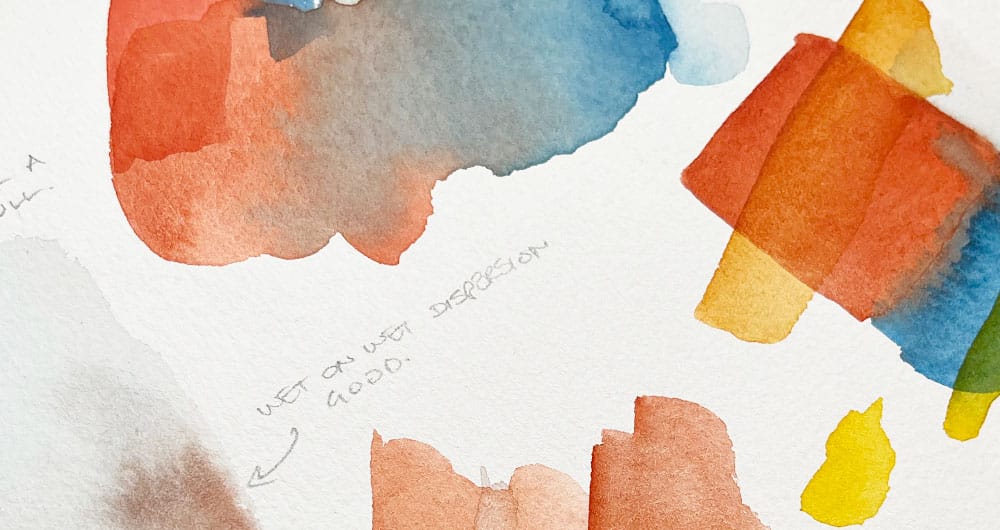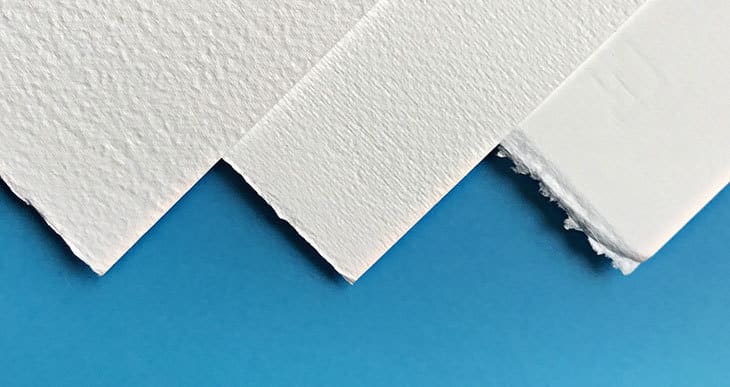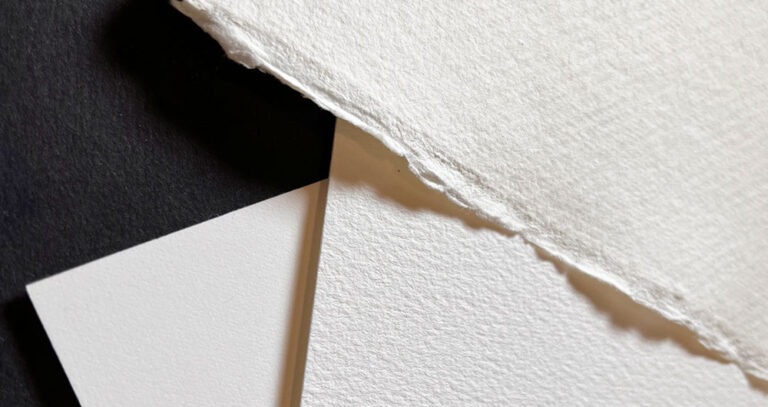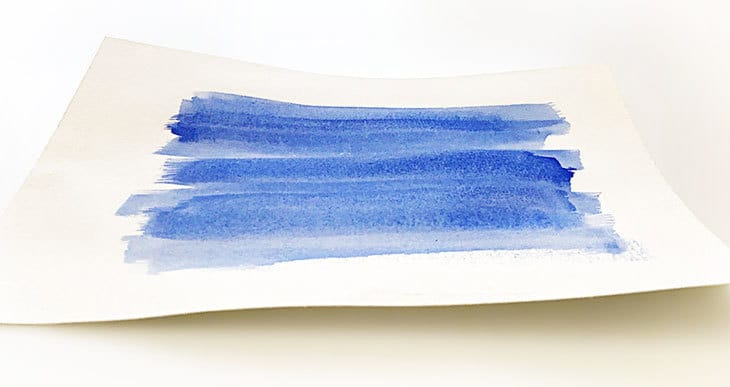Watercolor Paper Sizing (Explained!)

All watercolor paper is sized.
And no… I’m not talking about the dimensions of the sheet 🙂
As you begin to understand more about your art materials, at some point, you’ll come across the topic of sizing.
Sizing is a substance that is added to paper to modify its handling properties. Each type and brand of watercolor paper is sized differently. It’s a traditional method of making watercolor paper perform as it should. Without it, your paint would do all kinds of weird things on the sheet’s surface.
As a beginner, I used to find this pretty confusing!
What exactly does sizing do, and how does it affect the way you paint with watercolors?
In this article, I’ll explain everything you need to know.
What is watercolor paper sizing?
Sizing is used to alter the absorbent qualities of paper. Watercolor paper absorbs paint directly into the fibers like a sponge without sizing. Traditional sizing uses gelatin, but plant-based and synthetic sizing are also commonly used. Size can be applied internally, externally, or sometimes both.
Sizing influences three properties of watercolor paper:
- Its Absorbency
- Its Strength
- The Color appearance
Artist-quality paper is traditionally sized with gelatin (an animal-based by-product of the food industry). This is a naturally transparent and water-soluble substance, but it has a slightly yellowish color. Adding gelatin produces a creamy-colored paper rather than bright white.
It’s possible to add brightening agents to paper, but these degrade over time. On the other hand, papers without brighteners keep their color properties for longer.
The strength of the paper is also influenced by sizing. Surface sizing provides a hard coating that protects the paper from wear and abrasion.
Finally, the degree of internal and surface sizing modifies the permeability and absorbent qualities of the sheet.
External vs. internal sizing of watercolor paper
A quick note about two different methods of sizing commonly used in the production process:
- Internal sizing
- External sizing
Internal sizing happens in the early stages of the paper manufacturing process. It is added to the wet paper pulp before the sheets are formed.
External sizing (also called tub or surface sizing) happens at the end of the process. First, the paper sheets are dried and then dipped in a gelatin bath, coating the external surface.
External size bestows a crisp hard outer surface on the paper. In contrast, internal sizing modifies the structural properties slightly and helps to keep sheets stiff and more dimensionally stable.
Why is sizing important?
Most artist-quality watercolor paper is mold-made or handmade and purposely designed for painting with wet media. Sizing is a vital ingredient because it significantly affects the handling properties of the paper during painting.
Good watercolor paper brings out the best in watercolor paint and highlights its best qualities!
That’s the whole point 🙂
The sizing agent allows the wet paint to remain on the surface long enough for you to work without sucking colored pigments deep into the fibers.
If the pigments are entirely absorbed, you can’t continue to play with the paint. It fixes in place. Most good watercolor papers allow time to move pigments around in a wet wash or lift color off the surface if needed. On the other hand, if sizing is too strong (hard), the pigments never get absorbed and float around on the surface for too long.

At the same time, thanks to the sizing, the slightly impermeable surface allows the dry paint strokes to settle near the surface of the paper. This emphasizes the colors making them more luminous and vibrant! (if the sizing is poorly done, paint gets soaked up, resulting in flat-looking colors).
As you can probably tell… Good sizing is a bit of a balancing act! It has to resist the wet paint just enough to improve its handling properties, but not too much, or it would never stay put!
The amount of sizing
The amount of sizing used during the paper-making process significantly impacts how the paper handles during painting.
There are three general categories of sized paper:
- Unsized paper
- Soft sized
- Hard sized
Unsized paper (sometimes called water-leaf) is the kind that absorbs moisture the most. Think of blotting paper or the filter paper used to make coffee. Paper towels and kitchen rolls are other good examples.
Soft-sized paper includes things like newsprint. (These are perfect for printing because the ink needs to absorb deep into the fibers and stay there.)
Hard-sized includes all types of coated art paper, such as watercolor paper 🙂

So soft or hard sizing can be considered a measure of absorbency. You can tell if a sheet is hard-sized by dripping a few water droplets on the surface. If it stays on the surface without moving, it is relatively hard-sized. If it absorbs quickly or diffuses into the paper, it is either soft-sized or unsized.
Of course, these are broad categories, and the degree of sizing used in the production process differs quite a bit.
Handmade papers will have the biggest discrepancies from one batch to another.
And each brand has its own way of doing things!
As a result, Arches watercolor paper will behave slightly differently from Strathmore or Fabriano Artistico. The amount of sizing can be softer or harder depending on the manufacturer’s choice.
This is where things get tricky!
Your brand choice can make a big difference in how you paint.
Sized papers improve the workability and handling properties of the paper surface. Well-sized watercolor paper offers a perfect balance of absorption and, at the same time, allows the paint to flow and disperse correctly on the paper surface.
This is important because it influences the watercolor techniques you employ while painting.
For example, glazing is an essential technique in watercolor painting (this is where you apply subsequent layers of color, one on top of the other). However, for glazing to work properly, you must let the underlying paint dry before applying the next layer.
Now imagine a sheet of watercolor paper that isn’t correctly sized. If the sizing prevents the pigments from fixing to the paper fibers, glazing becomes problematic. Each new brushstroke will reactivate the first layers. All the colors mix and blend together each time you paint a new glaze.

Lifting is also a helpful technique for watercolor artists and is affected by sizing (this is a method where you remove paint from the surface by re-wetting it or soaking up some of the colors from the paper with a brush).
If the sizing is too soft (too absorbent), the pigments are drawn deep into the paper fibers. Therefore, they will be difficult to remove using lifting techniques.
Some papers are easy to lift but difficult to glaze. I find Fabriano Artistico to be like this. Lifting works well, but you must wait for the surface to dry completely before applying a new glaze. If it doesn’t dry sufficiently, the underlying pigments get easily disturbed.
Wet-on-wet techniques are also widely used in watercolor painting.
Some types of paper (student-grade paper in particular) have very hard sizing, preventing the pigments from being absorbed and causing excessive dispersion on the surface.
Personally, I’ve become accustomed to using Arches. The surface makes it relatively easy to handle glazing techniques. You have time to play with the paint, and wet-on-wet methods disperse perfectly.
Keep in mind the handling qualities of different grades and brands of paper can vary widely. Student-grade watercolor sheets, in particular, have poor sizing. Try to find the one that suits your technique the best.
FAQ
That said, people often ask a few other questions about sized papers. Here are some replies to a few common queries:
Do I need to size watercolor paper?
All watercolor paper is pre-treated with sizing, so you do not need to size your paper. So long as it is labeled “watercolor,” it should be suitable for wet media.
Some artists use sizing mixed with paint to create a “ground .”They apply this as a light wash over the paper before starting a painting as a way to add an aesthetic effect.
But I’ve never found this necessary!
Does watercolor paper have sizing on both sides?
The majority of watercolor paper is sized on both sides. This is a result of the traditional paper-making process. The sizing is either added to the wet pulp or applied to the surface by dipping it in a gelatin bath. So inevitably, both sides of the paper are sized.
Does soaking watercolor paper remove the sizing?
Sometimes artists stretch their watercolor paper to ensure a flat surface while painting. Unfortunately, the paper is drenched during this process, which disturbs the surface sizing.
If you have ever stretched watercolor paper, you may have noticed that the surface texture ends up slightly fuzzy after stretching. This is because the expansion and contraction of the paper fibers and the loosening of the surface sizing cause this effect.
The surface sizing is still there, but there will be less of it. Less gelatin on the sheet also means you can do less lifting or scraping to remove errors.
Can the sizing on watercolor paper go bad?
Over time paper sizing can deteriorate, or the paper might have bad sizing for some reason. This can produce patchy-looking results when you apply a wash of color.
You can also get splotchy marks where too much sizing has been applied or grease marks from too much handling.
Sometimes this can be recovered by soaking and brushing the surface with clear water. It will dissolve the surface sizing, redistribute it across the surface, and help wash away any oily marks.
Further reading:
For an in-depth look at paper sizes read this !
A complete over view of watercolor paper







Anthony, I have a question. I haven’t started watercolour yet. I’m an amateur oil paint artist. Watercolour paper is too expensive in my country…could I buy thick board paper and size it with gelatine to get the right measure of absorbancy, more or less, of watercolour paper?
Hi
Yes, you could try this but it might take a bit of trial and error. And I don’t think you’ll ever get the same handling properties of specially made watercolor paper unfortunately.
Anthony, I love your articles. I find them thorough, clear, and to the point. The one thing missing is advice for artist’s that want to be cruelty free. It took me a long time before I finally found a high quality paper that was not sized with gelatin. The same for brushes and paints. I never suspected that paints might contain ox-gall. Just something you might want to keep in mind if you revise your articles or when you create new ones.
Hi Sherri
Definitely something to include in future articles 🙂
Suddenly having the money to purchase big rolls of Arches I am worried that the sizing might go bad. I keep it in the box, rolled up. But I am 62 and have 3 rolls, it will probably last me the rest of my life, if it doesn’t go bad. How can I make it last? or is there nothing to do?
Hi Laura
I don’t think you have to worry about the sizing degrading over time. This is rare unless you store it poor conditions (extremes of temperature). You might come across paper that has patchy sizing on the surface, with areas that seem to absorb more than others.
If needed, you can always try to restore the surface sizing with gelatin (even food-grade gelatin can be used). Mix up the gelatin with warm water and apply using a soft brush so you don’t rough up the surface fibers. You can also touch up patches and use the brush to blend out the sizing at the edges of the patchy area. Dampening the paper beforehand can also help. Do some testing on a small area first. The more gelatin you apply the less absorbent and stiff the paper becomes! Hope that helps 🙂
Thanks, this was very useful for understanding why some paper I’d left out and handled a lot was acting more like kitchen roll than watercolour paper!
You’re welcome Jeff – happy to help